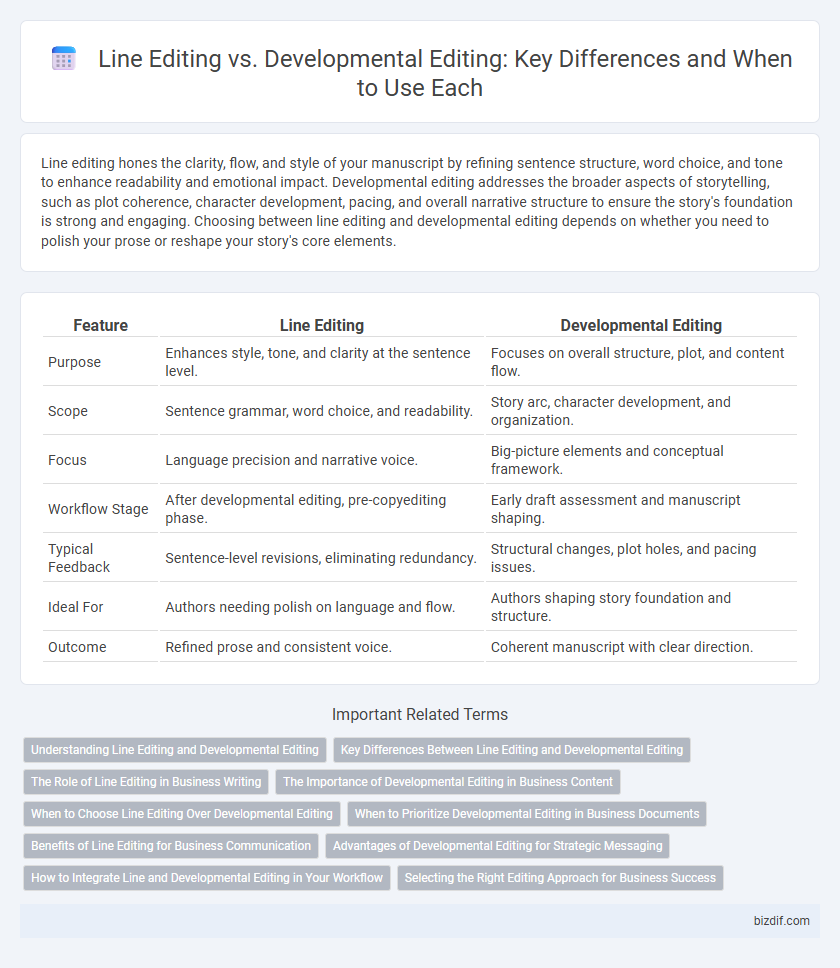Line editing hones the clarity, flow, and style of your manuscript by refining sentence structure, word choice, and tone to enhance readability and emotional impact. Developmental editing addresses the broader aspects of storytelling, such as plot coherence, character development, pacing, and overall narrative structure to ensure the story's foundation is strong and engaging. Choosing between line editing and developmental editing depends on whether you need to polish your prose or reshape your story's core elements.
Table of Comparison
| Feature | Line Editing | Developmental Editing |
|---|---|---|
| Purpose | Enhances style, tone, and clarity at the sentence level. | Focuses on overall structure, plot, and content flow. |
| Scope | Sentence grammar, word choice, and readability. | Story arc, character development, and organization. |
| Focus | Language precision and narrative voice. | Big-picture elements and conceptual framework. |
| Workflow Stage | After developmental editing, pre-copyediting phase. | Early draft assessment and manuscript shaping. |
| Typical Feedback | Sentence-level revisions, eliminating redundancy. | Structural changes, plot holes, and pacing issues. |
| Ideal For | Authors needing polish on language and flow. | Authors shaping story foundation and structure. |
| Outcome | Refined prose and consistent voice. | Coherent manuscript with clear direction. |
Understanding Line Editing and Developmental Editing
Line editing focuses on refining the sentence structure, word choice, and flow to enhance clarity and style within individual paragraphs. Developmental editing addresses the overall structure, plot coherence, character development, and pacing to shape the manuscript's big picture. Understanding these distinctions helps writers choose the right editing phase for improving both micro-level language and macro-level content.
Key Differences Between Line Editing and Developmental Editing
Line editing focuses on refining sentence structure, word choice, and flow to enhance clarity and style at the paragraph level, ensuring the manuscript reads smoothly. Developmental editing addresses the broader aspects of narrative structure, plot development, character arcs, and overall content organization to strengthen the story's foundation and coherence. Key differences include scope, with line editing targeting micro-level language improvements, while developmental editing works on macro-level storytelling and structural elements.
The Role of Line Editing in Business Writing
Line editing enhances business writing by refining sentence structure, clarity, and tone to ensure the message resonates effectively with the target audience. It focuses on word choice, syntax, and flow, improving readability without altering the overall content or organization. This detailed editing stage bridges the gap between raw drafting and polished communication, crucial for persuasive reports, proposals, and professional correspondence.
The Importance of Developmental Editing in Business Content
Developmental editing plays a crucial role in business content by ensuring the structure, clarity, and overall coherence align with the strategic goals of the organization. Unlike line editing, which focuses on sentence-level grammar and style, developmental editing addresses the bigger picture, including content organization, target audience engagement, and messaging effectiveness. This process helps businesses convey their value proposition clearly and persuasively, ultimately enhancing brand credibility and audience response.
When to Choose Line Editing Over Developmental Editing
Line editing is ideal when a manuscript's overall structure and content are sound but require refinement in sentence flow, word choice, and tone to enhance readability and engagement. Choose line editing after completing major revisions or developmental edits, ensuring the foundation is solid before focusing on clarity, style, and voice. Prioritize line editing when the story arc, character development, and plot are finalized, aiming to polish language and improve the manuscript's immediate impact.
When to Prioritize Developmental Editing in Business Documents
Developmental editing should be prioritized in business documents when the overall structure, messaging, and coherence require enhancement to effectively communicate strategic goals. This stage addresses issues such as unclear organization, inconsistent tone, and gaps in content that impact the document's persuasive power. Line editing, focusing on grammar and style, is ideal only after the foundational elements are solidified through developmental editing.
Benefits of Line Editing for Business Communication
Line editing enhances business communication by refining clarity, tone, and flow, ensuring messages are precise and professional. It improves readability and engagement, helping to convey complex information effectively to clients and stakeholders. This meticulous editing process boosts brand credibility and supports consistent, impactful corporate messaging.
Advantages of Developmental Editing for Strategic Messaging
Developmental editing enhances strategic messaging by aligning content structure with overarching communication goals, ensuring clarity and coherence for target audiences. It allows for comprehensive feedback on plot, character development, and thematic elements, resulting in a more compelling narrative that supports branding and messaging strategies. This process ultimately strengthens the impact and effectiveness of the written work in conveying key messages.
How to Integrate Line and Developmental Editing in Your Workflow
Integrate line editing and developmental editing by first addressing the manuscript's overall structure, plot coherence, and character development during the developmental editing phase to establish a solid foundation. Follow with line editing to refine sentence clarity, flow, and language precision, enhancing readability and style. Coordinating both editing types systematically improves narrative consistency and elevates the manuscript to professional publishing standards.
Selecting the Right Editing Approach for Business Success
Choosing between line editing and developmental editing depends on the business's specific goals and manuscript condition. Line editing refines sentence structure, clarity, and style to enhance readability, ideal for polishing near-final drafts. Developmental editing restructures content, addresses plot and character development, and ensures overall narrative coherence, crucial for foundational improvement and strategic content alignment.
Line Editing vs Developmental Editing Infographic

 bizdif.com
bizdif.com